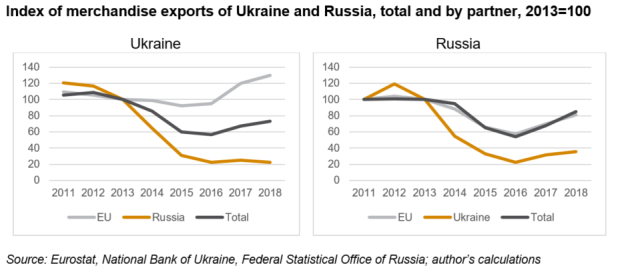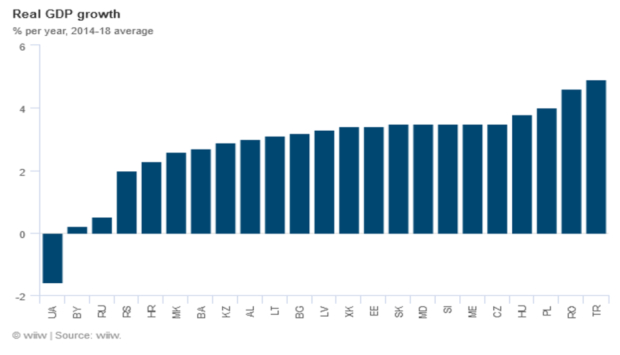War in the Donbass: Five years on, is there any hope of a durable peace?
02 September 2019
After half a decade of conflict in Eastern Ukraine, the new president has come to power promising a breakthrough. Can he succeed?
By Katharine Hornish
photo: iStock.com/IG Royal
- Two formal agreements, Minsk I and II, have failed to halt conflict in the Donbass region between the Ukrainian government and Russian-backed separatists.
- Since 2014, economic ties between Ukraine and the EU have become closer while ties between the EU and Russia have become more distant. Both countries have suffered economically.
- Newly-elected Ukrainian President Volodymyr Zelensky offers a renewed commitment towards a peaceful resolution.
- Despite his efforts, the Ukrainian strategy is unlikely to force Russian-backed separatists to give up their cause. As a result, the chances of a durable peace in the Donbass appear quite low.
The political crisis in the Donbass region dates back to November of 2013, when the Ukrainian government suspended preparations for an Association Agreement and Free Trade Agreement with the EU, leading to mass protests in the capital of Kiev and eventual overthrow of President Viktor Yanukovych in February 2014. Following this political change in Kiev, demonstrations led by anti-government, pro-Russian separatists clashed with the Ukrainian army and paramilitary groups beginning in March of 2014, kicking off a full-fledged struggle for control of the Donbass region.
Five years later, more than 13,000 people are estimated to have died, and 1.5 million have been displaced. This conflict, in combination with the Russian annexation of Crimea, has resulted in a sharp reduction in trade and investment flows between Russia and the EU/West, which, to a large extent, is a result of the economic sanctions by Western countries on Russia and Russian counter-sanctions imposed in summer 2014. Five years on, is there any hope of peace and a denouement in relations between Russia, Ukraine and the West, and of an improvement in economic ties?
Minsk agreements call for immediate ceasefire
In an effort to halt the conflict between pro-Russian separatists and the Ukrainian forces, the leaders of Ukraine, Russia and representatives from the Organization for Security and Cooperation in Europe (OSCE), met in Minsk in September of 2014 to outline a protocol for de-escalation in the Donbass, dubbed the Minsk Protocol or Minsk I. Together, they proposed twelve steps towards peace, including an immediate ceasefire, decentralization of power, removing unlawful military presence in Ukraine and local elections in the Donbass region.
In all, the ceasefire had little effect. Over the latter part of 2014 and into the beginning of 2015, the Russian-backed forces increased their presence and took over an additional 500 square km of territory.
The leaders of France, Germany, Russia and Ukraine met once again in Minsk on 12 February 2015 to outline a plan for the implementation of the Minsk protocol outlined in their first meeting. The new set of measures, dubbed Minsk II, included an immediate ceasefire and withdrawal of heavy weapons, constitutional reform to enable decentralization and restoration of Ukraine-Russia border controls.
Current state of play
Five years has passed since Minsk II, yet the conflict still persists. Since the failure of Minsk II’s ceasefire, aggression between the Russian-backed separatists and the Ukrainian army has taken the form of regular, small-scale confrontations, with a surge of violence during the spring of 2018. In addition to military-grade fighting, Russian hackers have been suspected of targeting Ukrainian government and business computer systems, causing the greatest effect on power sources for the city of Kiev.
The measures agreed upon by Russia and Ukraine during their second meeting in Minsk have failed to be fully implemented. Besides a few agreed-upon days of peace, there has been no ceasefire from either side. They have been able to create a 'buffer zone', but the withdrawal of heavy weapons has only been partial. Citizens in the region have not been able to fully participate in Ukrainian elections, and economic ties with the rest of Ukraine are reduced to a bare minimum, due in part to a trade ban imposed by Ukraine in the spring of 2017. Russian-backed personnel still occupies parts of the Donbass and controls sections of the state border.
The only measure that has been implemented is an increased intensity of contact between members of the Trilateral Contact Group, made up of representatives from Russia, Ukraine and OSCE; yet, their effectiveness at easing the conflict has been minimal. If anything, the Minsk agreements created an environment for low-intensity conflict rather than high-intensity, since both sides have withdrawn some of their weapons but are not willing to fully relinquish some type of force-based control.
Conflict has shifted Ukrainian economic ties towards the EU and Russian economic ties away from the EU
The EU and the US first introduced restrictive measures against Russia in March of 2014, and Russia retaliated with its own measures. Both the EU and the US have now extended their sanctions until 2020. The exchange of sanctions between Russia and the West since 2014 has had two important economic implications for Russia and Ukraine.
First, it has contributed to the latter to becoming more integrated with the EU, and the former less so. The Deep and Comprehensive Free Trade Area (DCFTA) agreement and autonomous preferences the EU granted to Ukraine even before the DCFTA enabled duty-free access of Ukrainian goods to the EU market, contributing considerably to a closer relationship between Ukraine and the EU. In addition, the exchange of trade sanctions between Ukraine and Russia has had an indirect effect of reorientation of Ukrainian trade from Russia towards the EU. As a result, Ukraine’s merchandise exports to the EU have been expanding at a fast rate, while exports to Russia have plummeted. Geographical structure of Ukraine’s exports has changed dramatically during 2013-2018: the share of Russia decreased by 16 p.p. to 8%, while the share of the EU has increased by 15 p.p. to 42%.
During 2013-2018, Russia’s exports to Ukraine have plunged as well, slight growth in 2017-2018 occurred primarily due to growing global prices of oil and metals, key export commodities. Similar trends, though at a smaller scale, have been observed in Russia’s exports to the EU.
The second implication has been for growth in general, with both countries affected negatively by the conflict. From a regional perspective, Ukraine and Russia, along with Belarus, have the lowest growth rates in Eastern Europe, with an average of -1.6% and 0.5% since 2014, respectively (see chart 2). For Turkey and Poland, for example, the equivalent rates were 4.9% and 4.0%, respectively. Although especially for Russia, other factors have been more important in holding down growth (such as lower oil prices and structural issues), in both Ukraine and Russia, the level of economic activity would have been higher without the conflict and resulting sanctions. In Russia, the sanctions have contributed to highly restrictive monetary and fiscal policies.
Prospects of change?
Although at times the intensity of fighting has increased, the conflict in the Donbass region has increasingly resembled a frozen conflict. Pro-Russian forces in the region are determined to prevent closer ties between the former-Soviet state and the EU, NATO and Western states. Yet, recent developments may give hope to a change in the nature of war in the Donbass, and for a possible durable peace, for two main reasons.
First, the conflict in the Donbass is very costly for Russia. Annually, Russia spends an estimated $2 billion in the Donbass region on non-military expenditures alone, in addition to the $2 billion per year spent on non-military expenditures in Crimea. The EU, US and Canada continue to extend and expand sanctions on the Russian economy over its presence in Ukraine, adding to the financial pain for Moscow. Moreover, according to our most recent country forecast, the Russian economy is on the verge of a recession, with stagnant real GDP since the second quarter of 2018. Depending on the future economic developments, Russia could be prompted to decrease its funding for maintaining its presence in the area.
The second possibility of a breakthrough comes in the form of recent presidential and parliamentary elections in Ukraine, which creates a new domestic political backdrop. Volodymyr Zelensky won the presidential election in May by a landslide, receiving 73% of votes, and his party won an overall majority in parliament. In his inaugural address, President Zelensky stated that a peaceful solution to the conflict was his “main priority”.
Since his election, President Zelensky has taken several steps towards resolution. He has already paid a visit to both France and Germany which focused on building diplomatic ties. On a separate trip to Toronto, Mr Zelensky met with Justin Trudeau and the Deputy Managing Director of the IMF (the latter is a key financial player in Ukraine). There, he discussed his plans to achieve peace by political and diplomatic means through a permanent cease-fire and increased sanctions by EU members, the US and Canada towards Russia. He also hosted Donald Tusk, President of the European Council, for the 21st Ukraine-EU Summit in Kyiv where both discussed increasing political and economic ties between the EU and Ukraine while also condemning Russian infringement on Ukrainian sovereignty and its passport program.
Challenges to peaceful resolution
Despite these factors, the challenges to a peaceful and durable solution to the conflict in the Donbass remain huge. In particular, the obstacles to neither Russia nor Ukraine being able to uphold their respective sides of the Minsk II agreements appear formidable.
From the Ukrainian side, the full implementation of the Minsk II agreements would be seen by the public as a betrayal of national interest to protect Ukrainian sovereignty. Many candidates in the recent election ran on a platform seeking a renegotiation of the Minsk agreements with the help of EU member countries.
Meanwhile from the Russian side, the agreements require the complete withdrawal of Russian-backed weapons and forces as well as disarming 'illegal groups' or the rebel forces. The pro-Russian rebels seek to return the eastern Ukrainian region to Russian control due to close historical and political ties. In leaked recordings, called the Glazyev Tapes, an advisor to Putin, Sergey Glazyev, and several pro-Russian separatists discuss strategy and financing for anti-government protests. Russian Communist Party leader, Gennady Zyuganov, has publically discussed his position towards annexing the Donbass region, stating that he would “immediately accept Donbass [into Russia]”. Most recently, Russia has started extending passports to those in eastern Ukraine. Complying with the Minsk agreements by withdrawing and returning control of the region to Ukraine would effectively mean giving up their pro-Russian, anti-established Ukrainian government cause.
More of the same
Despite increased diplomacy and difference in rhetoric towards the conflict, the approach from both Ukraine and the West is likely to be more of the same. The substance of Mr Zelensky’s strategy, for example, mirrors previous attempts at resolution. In the most recent report on the state of Russia-EU political relations, the EU outlined plans to maintain restrictive measures towards Russia until the Minsk Agreements have been fulfilled and Ukraine’s territorial sovereignty has been restored, among other requirements. Meanwhile from the US side, economic sanctions and other restrictive actions against Russia would not be lifted even with the implementation of the Minsk agreements, due to a variety of issues, including alleged Russian interference in the 2016 US Presidential election. In fact, the US plans on increasing military presence in Ukraine, providing anti-ship and anti-aircraft missiles.
Any approach that relies on maintaining or increasing Western sanctions on Russia will probably not work in the near future. While Russia’s economy has slowed down and may be close to recession, the sanctions have not had any apparent impact on the government’s calculations regarding Ukraine.


